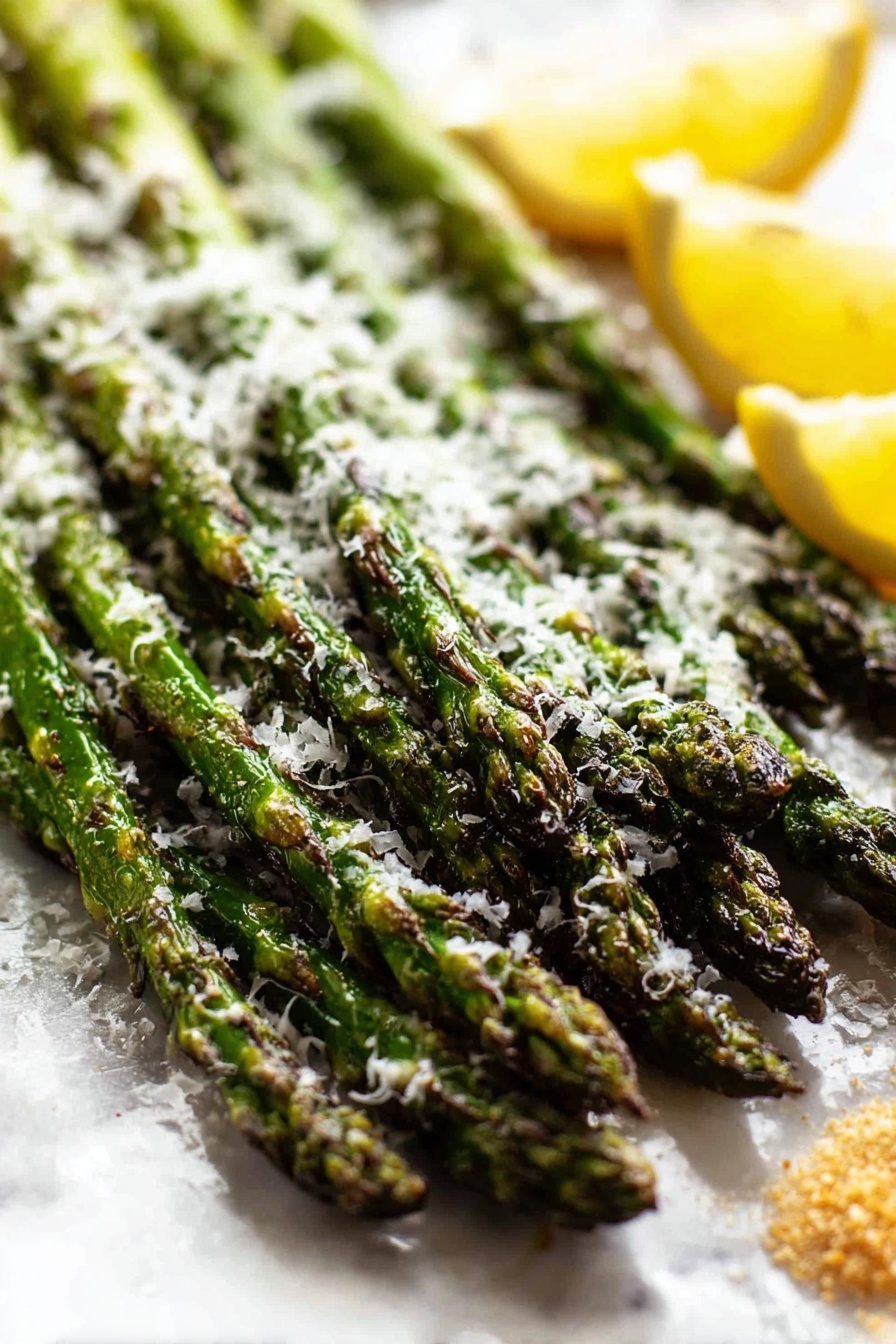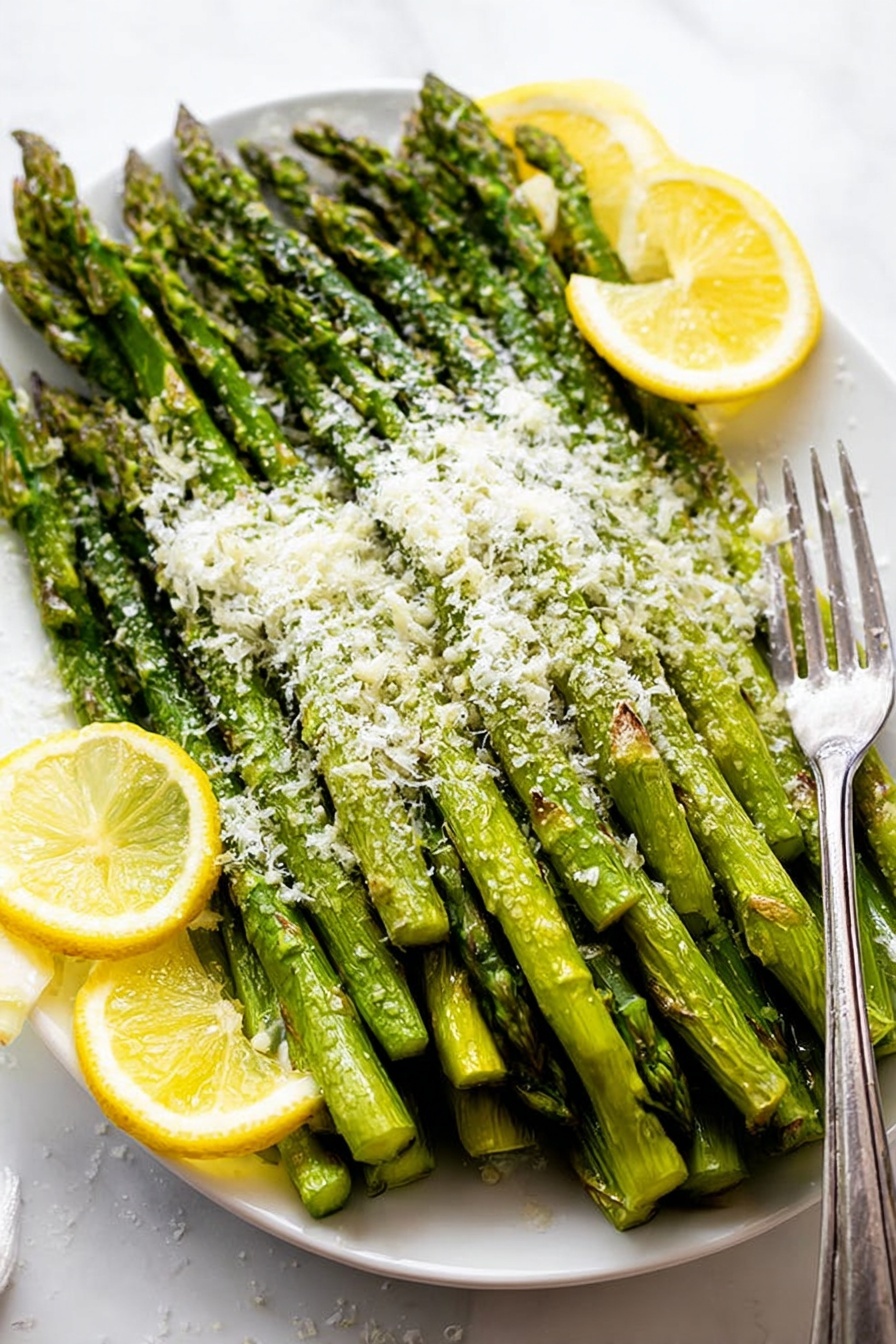There’s something about the bright, fresh zing of lemon paired with nutty parmesan that takes simple asparagus from everyday to exceptional. This Roasted Asparagus with Lemon and Parmesan Recipe is one of my go-to side dishes when I want something quick, vibrant, and absolutely delicious.
Jump to:
- Why You'll Love This Recipe
- Ingredients & Why They Work
- Make It Your Way
- Step-by-Step: How I Make Roasted Asparagus with Lemon and Parmesan Recipe
- Top Tip
- How to Serve Roasted Asparagus with Lemon and Parmesan Recipe
- Make Ahead and Storage
- Frequently Asked Questions:
- Final Thoughts
- Roasted Asparagus with Lemon and Parmesan Recipe
Why You'll Love This Recipe
This recipe is one of those gems I revisit when I want an easy side that looks and tastes like you’ve put a bit of extra love into dinner. The roasting brings out the asparagus’s natural sweetness, while lemon and parmesan brighten and deepen the flavor in such a satisfying way.
- Simple but Flavorful: Roasting asparagus with garlic and olive oil caramelizes their edges without fuss, making every bite perfectly tender-crisp.
- Quick and Easy: From prep to plate in under 20 minutes—perfect for busy weeknights or last-minute guests.
- Customizable Touches: The addition of fresh lemon juice and Parmesan cheese allows you to add personality with bright acidity and savory richness.
- Beautiful Presentation: It looks stunning on the plate, especially when finished with a shower of cheese and a squeeze of fresh lemon.

Ingredients & Why They Work
Every ingredient here pulls its weight, creating a perfect harmony of flavor and texture. Asparagus is the star, but the olive oil ensures crisp roasting, garlic adds a subtle pungency, while lemon juice and Parmesan finish with brightness and umami that make you want to keep coming back for more.

- Asparagus: Fresh, firm spears with bright green tips are key; avoid limp or woody stalks for best roasting results.
- Extra Virgin Olive Oil: Use good quality for the best depth of flavor and to help the asparagus crisp up under high heat.
- Salt & Pepper: Simple seasoning enhances the veggies’ natural goodness without overpowering them.
- Garlic: Finely minced garlic infuses the oil and asparagus during roasting, giving a gentle savory kick—not too strong, but just enough.
- Lemon Juice (optional): Adds a zesty freshness that livens the dish and balances the richness of the Parmesan.
- Parmesan Cheese (optional): Freshly grated is a must for that melty, nutty finish that turns simple asparagus into something special.
Make It Your Way
One of my favorite things about this Roasted Asparagus with Lemon and Parmesan Recipe is how easy it is to tweak. I often switch up the finishing touches depending on what I have on hand or the occasion—sometimes adding toasted nuts for crunch, or swapping out Parmesan for Pecorino for a sharper bite.
- Variation: Once, I tried adding a sprinkle of chili flakes before roasting, and it was a fantastic way to bring a little heat without overpowering the fresh flavors.
- Dairy-Free: If you want to skip the cheese, a light drizzle of balsamic glaze or nutritional yeast makes a delicious alternative.
- Seasonal Change: When asparagus is out of season, try this technique with green beans or broccolini for a similar delicious effect.
Step-by-Step: How I Make Roasted Asparagus with Lemon and Parmesan Recipe
Step 1: Prepare Your Asparagus
The first thing I do is snap off the woody ends of the asparagus. The cool trick is you don’t have to guess—each stalk naturally breaks where the tender part ends, so just hold it at the base and give it a snap. Easy and no need for a knife. Then I pile the spears on a baking tray big enough to spread them out.
Step 2: Season and Oil
Next, drizzle the asparagus with extra virgin olive oil, sprinkle over finely minced garlic (just one clove—too much garlic can overwhelm), salt, and freshly cracked black pepper. I toss everything right there on the tray, making sure each spear is lightly coated. Spreading them out in a single layer helps them roast evenly and develop that perfect little char.
Step 3: Roast to Perfection
Pop the tray into a hot oven—220°C (430°F) or 200°C fan—and roast for about 7 minutes for standard thickness. If your asparagus spears are extra thick, they might need up to 12 minutes. Keep an eye out—you want some color on the ends but no wrinkles or shriveling; the asparagus should still have a gentle snap.
Step 4: Brighten and Serve
As soon as they’re out of the oven, I squeeze fresh lemon juice over the asparagus. This step adds a lovely zing and balances the richness. Finally, a generous grating of Parmesan over the top really brings everything together. Serve warm on a platter—simple, stunning, and absolutely delicious.
Top Tip
From many batches of roasted asparagus, I’ve learned a few things that really make this recipe shine and ensure you’ll get consistent results every time.
- Choose Fresh, Uniform Asparagus: Picking spears of similar thickness helps them cook evenly without some being overdone while others remain tough.
- Don’t Overcrowd the Pan: Give each spear space on your baking tray. You want that dry heat roasting effect, not steaming.
- Watch the Time Closely: Roasting can quickly go from perfectly tender to mushy, so check at the 7-minute mark and decide if you want to go a couple more minutes depending on spear thickness.
- Use Fresh Lemon Juice: Bottled lemon juice just doesn’t have the same brightness. A quick squeeze of fresh lemon right before serving wakes up the whole dish.
How to Serve Roasted Asparagus with Lemon and Parmesan Recipe

Garnishes
I personally love finishing this asparagus with a few more things—sometimes a sprinkle of toasted pine nuts adds crunch and a lovely nutty twist. A few fresh basil or parsley leaves scattered on top bring a pop of color and freshness that’s simply inviting.
Side Dishes
This roasted asparagus pairs wonderfully with just about anything—from simply grilled chicken or seared steak to a creamy risotto or buttery mashed potatoes. I often serve it alongside a herby quinoa salad for a light, well-rounded meal.
Creative Ways to Present
For special dinners, I arrange the asparagus fanned out on a long serving platter, drizzle extra lemon juice artistically, then shave generous curls of Parmesan on top using a vegetable peeler. It always impresses guests with minimal effort.
Make Ahead and Storage
Storing Leftovers
I usually store leftover roasted asparagus in an airtight container in the fridge for up to 2 days. It keeps its flavor well, though the texture softens a bit. I like to enjoy leftovers cold as a salad addition or gently warmed.
Freezing
Freezing roasted asparagus isn’t my favorite because it tends to get soft and lose its delightful texture. If you do want to freeze it, flash freeze on a tray first so the spears don’t stick together, then transfer to a freezer bag—but expect a different texture after thawing.
Reheating
To reheat, I recommend popping the asparagus back into a hot oven or toaster oven for a few minutes to refresh the crispness rather than microwaving, which makes them soggy and limp.
Frequently Asked Questions:
I don’t recommend frozen asparagus for roasting because it releases a lot of moisture and often turns mushy rather than crisp-tender. Fresh asparagus is best to get that perfect roast and texture.
Look for lightly browned, slightly caramelized tips with a tender but still firm snap when you bite into them. Overcooked asparagus become limp and wrinkly, so check around the 7-minute mark and adjust timing based on thickness.
You can prep the asparagus by trimming and seasoning it ahead of time, but it’s best to roast just before serving to maintain the texture and flavor. Leftovers should be stored refrigerated and reheated gently.
Parmesan is optional but highly recommended for added depth and a nutty, savory finish. If you need a dairy-free option, you can omit it or substitute with nutritional yeast or a sprinkle of toasted nuts.
Final Thoughts
This Roasted Asparagus with Lemon and Parmesan Recipe holds a special place on my table because it’s so simple, so quick, yet so packed with flavor. I love recommending it when friends ask for easy ways to impress with veggies—if you give it a try, I’m pretty sure it’ll become a favorite for you too. Just remember: fresh ingredients and careful timing are your best friends here, and don’t be shy with that lemon and Parmesan—it’s what makes the dish come alive!
Print
Roasted Asparagus with Lemon and Parmesan Recipe
- Prep Time: 5 minutes
- Cook Time: 12 minutes
- Total Time: 17 minutes
- Yield: 4 servings
- Category: Side Dish
- Method: Baking
- Cuisine: Australian
- Diet: Vegetarian
Description
A simple and delicious recipe for perfectly roasted asparagus, seasoned with garlic, olive oil, and optional lemon juice and parmesan for enhanced flavor. This quick side dish is tender with a slightly crispy end and ideal for complementing any main course.
Ingredients
Main Ingredients
- 500 g asparagus (1 lb, approximately 3 standard Australian bunches)
- 1 ½ tablespoon extra virgin olive oil
- ¼ teaspoon salt
- ¼ teaspoon pepper
- 1 garlic clove, finely minced
Optional Finishes
- 2 tablespoon lemon juice
- 2 tablespoon parmesan, freshly grated
Instructions
- Preheat the oven: Set your oven to 220°C (430°F) or 200°C (fan assisted) to get it ready for roasting.
- Prepare the asparagus: Snap off the woody ends of the asparagus; they will naturally break at the right spot. This ensures tenderness in the cooked asparagus.
- Season the asparagus: Place the asparagus on a baking tray. Drizzle with olive oil and sprinkle with salt, pepper, and the minced garlic. Toss everything together to coat the asparagus evenly, then spread it out in a single layer on the tray.
- Roast the asparagus: Place the tray in the oven and roast for 7 minutes. For very thick asparagus, roast for 10 to 12 minutes until the ends develop a bit of color and the stalks are just cooked through, but not wrinkly or limp.
- Remove and finish: Take the asparagus out of the oven. If using, toss with lemon juice for brightness, then transfer to a serving platter. Sprinkle freshly grated parmesan over the top if desired, and serve immediately.
Notes
- For the freshest asparagus, select stalks that are firm and bright green with tightly closed tips.
- Snap the ends instead of cutting with a knife to remove the woody, tough parts naturally.
- Adjust roasting time depending on the thickness of your asparagus stalks for perfect tenderness.
- The optional lemon juice adds a bright acidity that complements the roasted flavor.
- Parmesan can be substituted with nutritional yeast for a vegan option.
- This dish pairs well with grilled meats or as a healthy addition to any vegetarian meal.
Nutrition
- Serving Size: 125 g
- Calories: 70 kcal
- Sugar: 2 g
- Sodium: 150 mg
- Fat: 5 g
- Saturated Fat: 1 g
- Unsaturated Fat: 4 g
- Trans Fat: 0 g
- Carbohydrates: 5 g
- Fiber: 3 g
- Protein: 3 g
- Cholesterol: 3 mg







Leave a Reply